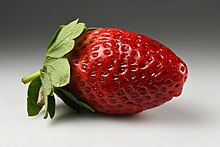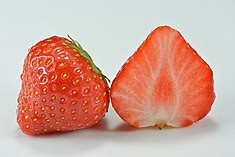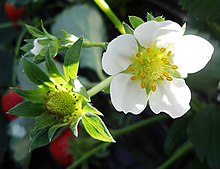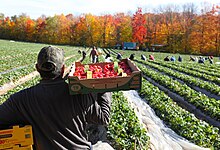Strawberry
| Strawberry Fragaria × ananassa | |
|---|---|

| |
| Strawberry fruit | |

| |
| Halved strawberry | |
| Scientific classification | |
| Kingdom: | Plantae |
| Clade: | Tracheophytes |
| Clade: | Angiosperms |
| Clade: | Eudicots |
| Clade: | Rosids |
| Order: | Rosales |
| Family: | Rosaceae |
| Genus: | Fragaria |
| Species: | F. × ananassa
|
| Binomial name | |
| Fragaria × ananassa | |
The garden strawberry (or simply strawberry; Fragaria × ananassa)[1] is a widely grown hybrid species of the genus Fragaria, collectively known as the strawberries, which are cultivated worldwide for their fruit. The fruit is widely appreciated for its characteristic aroma, bright red color, juicy texture, and sweetness. It is consumed in large quantities, either fresh or in such prepared foods as jam, juice, pies, ice cream, milkshakes, and chocolates. Artificial strawberry flavorings and aromas are also widely used in products such as candy, soap, lip gloss, perfume, and many others.
The garden strawberry was first bred in
From a botanical point of view, the strawberry is not a berry but an aggregate accessory fruit, meaning that the fleshy part is derived not from the plant's ovaries but from the receptacle that holds the ovaries.[4] Each apparent "seed" (achene) on the outside of the fruit is actually one of the ovaries of the flower, with a seed inside it.[4]
In 2019, world production of strawberries was nine million tons, led by China with 40% of the total.
History
This section needs additional citations for verification. (September 2023) |

The first garden strawberry was grown in Brittany, France, during the late 18th century.[3] Prior to this, wild strawberries and cultivated selections from wild strawberry species were the common source of the fruit.
The strawberry fruit was mentioned in ancient Roman literature in reference to its medicinal use. The French began taking the strawberry from the forest to their gardens for harvest in the 14th century. Charles V, France's king from 1364 to 1380, had 1,200 strawberry plants in his royal garden. In the early 15th century western European monks were using the wild strawberry in their illuminated manuscripts. The strawberry is found in Italian, Flemish, and German art, and in English miniatures.[citation needed] The entire strawberry plant was used to treat depressive illnesses.
By the 16th century, references of cultivation of the strawberry became more common. People began using it for its supposed medicinal properties and botanists began naming the different species. In England the demand for regular strawberry farming had increased by the mid-16th century.
The combination of strawberries and cream was created by

Two subspecies of F. vesca were identified: F. sylvestris alba and F. sylvestris semperflorens. The introduction of F. virginiana from eastern North America to Europe in the 17th century is an important part of history because it is one of the two species that gave rise to the modern strawberry. The new species gradually spread through the continent and did not become completely appreciated until the end of the 18th century. A French excursion journeyed to Chile in 1712, which led to the introduction of a strawberry plant with female flowers that resulted in the common strawberry.
The Mapuche and Huilliche Indians of Chile cultivated the female strawberry species until 1551, when the Spanish came to conquer the land. In 1765, a European explorer recorded the cultivation of F. chiloensis, the Chilean strawberry. At first introduction to Europe, the plants grew vigorously, but produced no fruit. French gardeners in Brest and Cherbourg around the mid-18th century first noticed that when F. moschata and F. virginiana were planted in between rows of F. chiloensis, the Chilean strawberry would bear abundant and unusually large fruits. Soon after, Antoine Nicolas Duchesne began to study the breeding of strawberries and made several discoveries crucial to the science of plant breeding, such as the sexual reproduction of the strawberry which he published in 1766. Duchesne discovered that the female F. chiloensis plants could only be pollinated by male F. moschata or F. virginiana plants.[6] This is when the Europeans became aware that plants had the ability to produce male-only or female-only flowers.
Duchesne determined F. ananassa to be a hybrid of F. chiloensis and F. virginiana. F. ananassa, which produces large fruits, is so named because it resembles the pineapple in smell, taste and berry shape. In England, many varieties of F. ananassa were produced, and they form the basis of modern varieties of strawberries currently cultivated and consumed. Further breeding was also conducted in Europe and America to improve the hardiness, disease resistance, size, and taste.[6]
With the Green Revolution of the 1950s, agronomists used selective breeding to expand phenotypic diversification of the garden strawberry. Adoption of perpetual flowering hybrids not sensitive to photoperiod changes gave higher yields and expansion of production in California.[7]
Composition
Nutrition
 | |
| Nutritional value per 100 g (3.5 oz) | |
|---|---|
| Energy | 136 kJ (33 kcal) |
7.68 g | |
| Sugars | 4.89 g |
| Dietary fiber | 2 g |
0.3 g | |
0.67 g | |
Niacin (B3) | 2% 0.386 mg |
| Pantothenic acid (B5) | 3% 0.125 mg |
| Vitamin B6 | 3% 0.047 mg |
| Folate (B9) | 6% 24 μg |
| Choline | 1% 5.7 mg |
| Vitamin C | 65% 58.8 mg |
| Vitamin E | 2% 0.29 mg |
| Vitamin K | 2% 2.2 μg |
| Minerals | Quantity %DV† |
| Calcium | 1% 16 mg |
| Iron | 2% 0.41 mg |
| Magnesium | 3% 13 mg |
| Manganese | 17% 0.386 mg |
| Phosphorus | 2% 24 mg |
| Potassium | 5% 154 mg |
| Sodium | 0% 1 mg |
| Zinc | 1% 0.14 mg |
| Other constituents | Quantity |
| Water | 90.95 g |
| †Percentages estimated using US recommendations for adults,[8] except for potassium, which is estimated based on expert recommendation from the National Academies.[9] | |
Raw strawberries are 91% water, 8%
Phytochemicals
Garden strawberries contain the dimeric
Color
Purple minor pigments consisting of dimeric anthocyanins (flavanol-anthocyanin adducts : catechin(4α→8)pelargonidin 3-O-β-glucopyranoside, epicatechin(4α→8)pelargonidin 3-O-β-glucopyranoside, afzelechin(4α→8)pelargonidin 3-O-β-glucopyranoside and epiafzelechin(4α→8)pelargonidin 3-O-β-glucopyranoside) can also be found in strawberries.[15]
Flavor and fragrance

Sweetness, fragrance and complex flavor are favorable attributes.
Chemicals present in the fragrance of strawberries include:
- methyl acetate
- (E)-2-hexen-1-ol
- (E)-2-hexenal
- (E)-2-pentenal
- (E,E)-2,4-hexadienal
- (Z)-2-hexenyl acetate
- (Z)-3-hexenyl acetate
- 1-hexanol
- 2-heptanol
- 2-heptanone
- 2-methyl butanoic acid
- 2-methylbutyl acetate
- alpha-terpineol
- amyl acetate
- amyl butyrate
- benzaldehyde
- benzyl acetate
- butyl acetate
- butyl butyrate
- butyl hexanoate
- butyric acid
- octanoic acid
- decyl acetate
- decyl butyrate
- d-limonene
- ethyl 2-methylbutanoate
- ethyl 3-methylbutanoate
- ethyl acetate
- ethyl benzoate
- ethyl butyrate
- ethyl decanoate
- ethyl hexanoate
- ethyl octanoate
- ethyl pentanoate
- ethyl propanoate
- ethyl-2-hexenoate
- α-farnesene
- β-farnesene
- furaneol
- γ-decalactone[18][19]
- γ-dodecalactone
- heptanoic acid
- n-hexanal
- hexanoic acid
- hexyl acetate
- isoamyl acetate
- isoamyl hexanoate
- isopropyl acetate
- isopropyl butanoate
- isopropyl hexanoate
- linalool
- mesifurane
- methyl anthranilate[18][19]
- methyl butyrate
- methyl hexanoate
- methyl isovalerate
- methyl octanoate
- methyl pentanoate
- methyl propanoate
- (E)-nerolidol
- nonanal
- nonanoic acid
- ocimenol
- octyl acetate
- octyl butyrate
- octyl hexanoate
- octyl isovalerate
- propyl butyrate
- propyl hexanoate[20]
As strawberry flavor and
Genetics
Modern strawberries are
Allergy
Some people experience an
White-fruited strawberry cultivars, lacking Fra a1, may be an option for strawberry allergy sufferers. Since they lack a protein necessary for normal ripening by anthocyanin synthesis of red pigments, they do not turn the mature berries of other cultivars red.[28] They ripen but remain white, pale yellow or "golden", appearing like immature berries; this also has the advantage of making them less attractive to birds. A virtually allergen-free cultivar named 'Sofar' is available.[29][30]
Varieties



Strawberries are often grouped according to their flowering habit.[31][32] Traditionally, this has consisted of a division between "June-bearing" strawberries, which bear their fruit in the early summer and "ever-bearing" strawberries, which often bear several crops of fruit throughout the season.[32] One plant throughout a season may produce 50 to 60 times or roughly once every three days.[33]
Research published in 2001 showed that strawberries actually occur in three basic flowering habits: short-day, long-day, and day-neutral. These refer to the day-length sensitivity of the plant and the type of
Uses
Culinary

In addition to being consumed fresh, strawberries can be frozen or made into jam or
In the United Kingdom, "strawberries and cream" is a popular dessert consumed at the
Fresh strawberries are used as cocktail garnishes to add flavor and texture to a drink.
Polyphenol extracted from strawberries have been used in Kanazawa, Japan, to create melting-resistant popsicles.[39]
Cultivation
Production
| Top Strawberry producers | |
|---|---|
| in 2021 | |
| Numbers in million FAOSTAT[40] |
In 2021, world production of strawberries was 9.2 million tonnes, led by China with 37% of the total and the United States and Turkey as other significant producers (table).
Due to the relatively fragile nature of the strawberry, approximately 35 percent of the $2.2 billion United States crop was spoiled in 2020. This led to an Idaho company planning to launch gene-edited strawberries in the near future in an effort to make them more durable. In the U.S. it costs growers around $35,000 per acre to plant and $35,000 per acre to harvest strawberries now, and more durable berries might reduce the rate of spoilage.[41]
For purposes of commercial production, plants are propagated from runners and, in general, distributed as either bare root plants or plugs. Cultivation follows one of two general models—annual plasticulture,[42] or a perennial system of matted rows or mounds.[43] Greenhouses produce a small amount of strawberries during the off season.[44]
The bulk of modern commercial production uses the plasticulture system. In this method, raised beds are formed each year, fumigated, and covered with plastic to prevent weed growth and erosion. Plants, usually obtained from northern nurseries, are planted through holes punched in this covering, and irrigation tubing is run underneath. Runners are removed from the plants as they appear, to encourage the plants to put most of their energy into fruit development. After harvesting, the plastic is removed and the plants are plowed into the ground.[42][45] Strawberry plants produce more and better fruit when they are young. After a year or two, they decline. Replacing them annually improves yields and enables denser planting.[42][45] However, this necessitates a longer growing season, for the plants to establish themselves. It also costs more to annually purchase plants, form new mounds, and cover them with (new) plastic.[45]
The other major method retains plants for multiple years. This is most common in colder climates. The plants are grown in rows or on mounds.[42][43] This method requires lower investment and lower maintenance, overall.[43] Yields are typically lower than in plasticulture.[43]
Another method uses a
Strawberries may also be propagated by seed, though this is primarily a hobby activity, and is not widely practiced commercially. A few seed-propagated cultivars have been developed for home use, and research into growing from seed commercially is ongoing.[48] Seeds (achenes) are acquired either via commercial seed suppliers, or by collecting and saving them from the fruit.
Strawberries can also be grown indoors in strawberry pots.[49] Strawberries will not grow indoors in winter unless aided by a combination of blue and red LED lights.[50] In Florida, winter is the natural growing season and harvesting begins in mid-November.[33]
The Kashubian strawberry (Truskawka kaszubska or Kaszëbskô malëna)
-
Strawberry field in North Rhine-Westphalia, Germany
-
A field using the plasticulture method
Manuring and harvesting
Most strawberry plants are now fed with
To maintain top quality, berries are harvested at least every other day. The berries are picked with the caps still attached and with at least half an inch of stem left. Strawberries need to remain on the plant to fully ripen because they do not continue to ripen after being picked. Rotted and overripe berries are removed to minimize insect and disease problems. The berries do not get washed until just before consumption.[53]

Soil test information and plant analysis results are used to determine fertility practices. Nitrogen fertilizer is needed at the beginning of every planting year. There are normally adequate levels of phosphorus and potash when fields have been fertilized for top yields. To provide more organic matter, a cover crop of wheat or rye is planted in the winter before planting the strawberries. Strawberries prefer a pH from 5.5 to 6.5, so lime is usually not applied.[54]
The harvesting and cleaning process has not changed substantially over time. The delicate strawberries are still harvested by hand.[55] Grading and packing often occurs in the field, rather than in a processing facility.[55] In large operations, strawberries are cleaned by means of water streams and shaking conveyor belts.
Domestic cultivation
Strawberries are popular in home gardens, and numerous cultivars have been selected for consumption and for exhibition purposes.[56] The following cultivars have gained the Royal Horticultural Society's Award of Garden Merit:
Marketing

In the United States in 2017, the collective commercial production of strawberries, blueberries, raspberries, and blackberries was a $6 billion industry dominated by the California growing and marketing company Driscoll's.[18] In 2017, strawberries alone were a $3.5 billion market of which 82% was for fresh fruit.[63]
To increase consumer demand in the 21st century, commercial producers of strawberries cultivated them mainly for favorable aroma characteristics similar to those of wild strawberries,
Pests
Around 200 species of pests are known to attack strawberries both directly and indirectly.[64] These pests include slugs, moths, fruit flies, chafers, strawberry root weevils, strawberry thrips, strawberry sap beetles, strawberry crown moth, mites, aphids, and others.[64][65] The caterpillars of a number of species of Lepidoptera feed on strawberry plants. For example, the ghost moth is known to be a pest of the strawberry plant.
The strawberry aphid, Chaetosiphon fragaefolii, is a bug species found in the United States (Arizona), Argentina and Chile. It is a vector of the strawberry mild yellow-edge virus.
The amounts of
Diseases
Strawberry plants can fall victim to a number of diseases, especially when subjected to stress.
The NPR1 gene from Arabidopsis thaliana,
A 1997 study assessed many
The plants can also develop disease from temperature extremes during winter.[67] Watering strawberry roots, and not the leaves, is preferred as moisture on leaves encourages fungal growth.[72] Strawberries may also often appear conjoined together or deformed due to poor pollination.[73]
See also
- California Strawberry Commission
- Fraise Tagada (strawberry-shaped candy popular in France)
- List of culinary fruits
- List of strawberry cultivars
- List of strawberry dishes
- Musk strawberry (hautbois strawberry)
- Plant City, Florida (winter strawberry capital of the world)
- Pineberry
- Pomology
- Strawberry cake
- Strawberry sauce
References
- PMID 24122646.
- ^ "Strawberry, The Maiden With Runners". Botgard.ucla.edu. Archived from the original on 6 July 2010.
- ^ a b Welsh, Martin. "Strawberries". Nvsuk.org.uk. Archived from the original on 2 August 2008.
- ^ ISBN 0-471-24520-8.
- ^ a b "Wimbledon's strawberries and cream has Tudor roots". BBC. 9 June 2015.
- ^ a b The strawberry; history, breeding, and physiology (PDF). New York Holt Rinehart and Winstonrived. 1966.
- .
- ^ United States Food and Drug Administration (2024). "Daily Value on the Nutrition and Supplement Facts Labels". Retrieved 28 March 2024.
- )
- ^ PMID 22153122.
- S2CID 5223760.
- ^ PMID 22339338.
- PMID 23121441.
- PMID 15884835.
- PMID 15231416.
- .
- ^ PMID 24523895.
- ^ a b c d e f g h i Dana Goodyear (14 August 2017). "How Driscoll's reinvented the strawberry". The New Yorker. Retrieved 26 June 2019.
- ^ PMID 25717332.
- .
- PMID 17954736.
- ^ "How Flavor Chemists Make Your Food So Addictively Good". io9. 8 November 2012. Retrieved 26 April 2014.
- ^ Cassell, D (2014). "2014 Flavor Trends: Yogurt's Fruitful Union". Food Processing. Retrieved 26 April 2014.
- PMID 24282021.
- PMID 30804557.
- ^ "Children and food allergies". California Pacific Medical Center. 2013. Retrieved 27 April 2014.
- S2CID 31952236.
- ^ PMID 19969523.
- S2CID 29423198.
- ^ Idea TV GmbH (21 June 2005). "The chemistry of strawberry allergy (includes 'Sofar' reference)". Innovations-report.com. Retrieved 9 March 2013.
- ^ a b "G6135 Home Fruit Production: Strawberry Cultivars and Their Culture". University of Missouri. Archived from the original on 2 July 2017. Retrieved 5 May 2009.
- ^ a b Sagers, Larry A. (15 April 1992). "Proper Cultivation Yields Strawberry Fields Forever". Deseret News. Archived from the original on 20 April 2007.
- ^ a b "10 facts about Florida strawberries that might surprise you". 7 March 2016. Retrieved 7 June 2018.
- ISBN 978-0-471-41847-4.
- ^ "Strawberry Seeds". Strawberry Plants. Retrieved 2 August 2016.
- ^ Fletcher, Stevenson Whitcomb (1917) Strawberry Growing, The Macmillan Co., New York, p. 127.
- S2CID 205838719.
- ^ Drummond, Ree (2011). "Strawberry Oatmeal Bars". Food Network. Retrieved 27 March 2013.
- ^ Huang, Echo (2 August 2017). "Japan has engineered a popsicle that "doesn't melt"". Quartz. Retrieved 14 August 2023.
- FAOSTAT). 2023. Retrieved 16 April 2023.
- ^ Ridler, Keith (28 October 2021). "US companies announce plans for gene-edited strawberries". Associated Press. Retrieved 29 October 2021.
- ^ a b c d "Strawberry Plasticulture Offers Sweet Rewards". Ag.ohio-state.edu. 28 June 2002. Archived from the original on 19 January 2010. Retrieved 5 December 2009.
- ^ a b c d "Strawberry Production Basics: Matted Row" (PDF). newenglandvfc.org. Archived from the original (PDF) on 3 April 2016. Retrieved 5 May 2009.
- ^ "Pritts Greenhouse Berried Treasures". Hort.cornell.edu.
- ^ a b c "Strawberry Fields Forever". Noble.org. Archived from the original on 26 November 2005. Retrieved 5 May 2009.
- PMID 20560628.
- PMID 14582984.
- S2CID 26544785.
- ISBN 9780903505352.
Strawberries grown indoors in strawberry pots.
- ^ "Strawberries in winter? Welcome to franken-season". The Independent. Archived from the original on 25 May 2022. Retrieved 7 June 2018.
- ^ "COUNCIL REGULATION (EC) No 510/2006 'TRUSKAWKA KASZUBSKA' or 'KASZËBSKÔ MALËNA' EC No: PL-PGI-0005-0593-19.03.2007". European Union. 18 April 2009.
- ^ "HS1116/HS370: Nitrogen Fertilization of Strawberry Cultivars: Is Preplant Starter Fertilizer Needed?". Edis.ifas.ufl.edu. 6 August 2007. Archived from the original on 21 January 2009. Retrieved 5 December 2009.
- ^ Bordelon, Bruce. "Growing Strawberries" (PDF). Purdue University.
- ^ "Production Guide for Commercial Strawberries" (PDF). Iowa State University.
- ^ a b "Commercial Postharvest Handling of Strawberries (Fragaria spp.)". Extension.umn.edu. Archived from the original on 8 July 2013. Retrieved 5 May 2009.
- ISBN 978-1-84533-434-5.
- ^ "Fragaria × ananassa 'Cambridge Favourite' (F) strawberry 'Cambridge Favourite'". Royal Horticultural Society. Retrieved 20 January 2023.
- ^ "Fragaria × ananassa 'Hapil' (F) strawberry 'Hapil'". Royal Horticultural Society. Retrieved 20 January 2023.
- ^ "Fragaria × ananassa 'Honeoye' (F) strawberry 'Honeoye'". Royal Horticultural Society. Retrieved 20 January 2023.
- ^ "Fragaria 'Pegasus' strawberry 'Pegasus'". Royal Horticultural Society. Retrieved 20 January 2023.
- ^ "Fragaria × ananassa 'Rhapsody' (F) strawberry 'Rhapsody'". Royal Horticultural Society. Retrieved 20 January 2023.
- ^ "Fragaria × ananassa 'Symphony' PBR (F) strawberry 'Symphony'". Royal Horticultural Society. Retrieved 20 January 2023.
- ^ "Strawberries". Agricultural Marketing Resource Center, US Department of Agriculture. 1 April 2019. Retrieved 26 June 2019.
- ^ a b "Insect Pests of Strawberries and Their Management". Virginiafruit.ento.vt.edu. 3 May 2000. Retrieved 5 December 2009.
- ^ "Radcliffe's IPM World Textbook | CFANS | University of Minnesota". Ipmworld.umn.edu. 20 November 2009. Archived from the original on 26 June 2009. Retrieved 5 December 2009.
- ^ Scipioni, Jade (12 April 2016). "Strawberries are Now the Most Contaminated Produce". Fox Business.
- ^ a b c d e "Strawberry Diseases". Extension.umn.edu. Archived from the original on 23 March 2009.
- ^ "Strawberry Diseases". Colorado State University. Retrieved 28 March 2018.
- ^ Pleasant, Barbara (2011). "All About Growing Strawberries". Mother Earth News (248): 23–25.
- ^ S2CID 17663129.
- • Inamdar, Arati A.; Morath, Shannon; Bennett, Joan W. (2020). "Fungal Volatile Organic Compounds: More Than Just a Funky Smell?". S2CID 84686620.
External links
- Fragaria × ananassa data from GRIN Taxonomy Database
- Thurber, George (1879). . The American Cyclopædia.
- . Encyclopædia Britannica (11th ed.). 1911.
- Demonstration of strawberry growth lifecycle timelapse on YouTube



